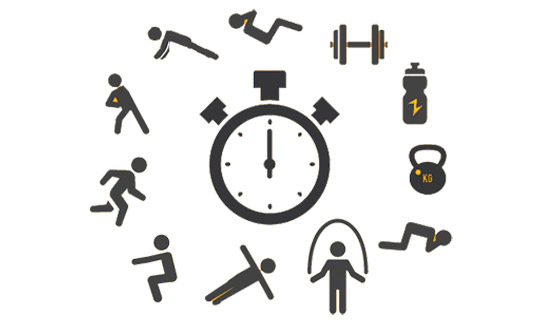
I. INTRODUCTION
Though there are various types of endurance training, e.g., walking, swimming, running, cycling, hiking etc., this chapter focuses only on running. Running is an excellent exercise for cardiovascular fitness. It hardly requires any equipment other than a good pair of shoes, some space and a will to run!
We will discuss here both aerobic (endurance) and anaerobic (speed) running. The term aerobic literally means ‘with oxygen’. During aerobic running there is enough oxygen available to your muscles. Therefore, you can run for hours, though at a slower speed. During running at high speed (anaerobic running) your body cannot meet the huge demand of oxygen to the muscles. Therefore, though you can run very fast, you cannot continue the activity for more than a few seconds.
ENDURANCE RUNNING
Before you undertake an exercise programme, remember these ten Mantras –
(i) BENEFITS –
There are many benefits of endurance running –1. It is an excellent fat-burning exercise. When you run, initially your body depends more on carbohydrates and less on fats for energy. But after 30-35 minutes, the situation reverses and body starts burning more fats than carbohydrates for its energy need.
(ii) It strengthens your cardiovascular system and protects against cardiovascular diseases.
(iii) It increases the number and diameter of capillaries. Capillaries transport oxygen in and waste products out from muscle fibres. The end result of this is availability of more oxygen and more energy in your body system.
(iv) It increases the number and size of mitochondria. Mitochondria are microscopic structures inside your muscles. They are termed as ‘power houses’ or ‘aerobic engines’. In the mitochondria carbohydrate, fat and protein break down in presence of oxygen and release energy. Therefore, bigger the size of mitochondria, the more energy will be generated for your longer, faster runs. This is one of the reasons, long distance runners go for slow long distance(SLD) runs to improve their performance.
(v) Regular running develops a healthy ‘addiction’ among runners. There is an increase in the mental alertness, awareness of surroundings, effortlessness, feeling of well-being, and euphoric relaxation especially after 30-40 minutes of continuous run. This phenomenon is termed as ‘runner’s high’ and is worth trying.
(vi) Long distance running at low intensity is one of the most powerful anti-depressant ‘natural’ drugs. Try it yourself. Next time when you get anxious, angry or depressed, put on your shoes and jog for 30-40 minutes. Your depression will vanish. I have tried it on several occasions with definite success (though for me it requires at least one hour of jog). Students may practise it before their exams, or before appearing for an important interview.
Back to top >
II ENDURANCE RUNNING PROGRAMME DESIGN
Your endurance running programme design will be guided by your specific goal. Let’s discuss the FITT factors for running.A. Frequency – 3-5 days of endurance run per week produces reasonable cardiovascular fitness. The number of training days per week depends on the intensity (heart rate) and volume (duration) of training. For beginners and non-athletes 3 days of training on alternate days will be sufficient. Athletes may train on 5-6 days with 1-2 days of rest. However, they have to alternate their training days as ‘hard’ and ‘easy’. Hard days will be marked by high intensity / high volume. Easy days will be marked by low intensity / low volume. Some studies suggest that one can maintain his aerobic fitness by training only 2 days per week, but for that your intensity/volume has to be on higher side.
B. Intensity – Intensity is the most important factor in endurance run programme design and hence it deserves a detailed discussion. In simple words, intensity in running is related to how hard you run. The ‘hardness’ or intensity, is measured by heart rate BPM (beats per minute). At increased intensity the heart rate also increases.
Let’s first understand these terms – Maximum Heart Rate (MHR), Resting Heart Rate(RHR), Training Heart Rate (THR) and Heart Rate Reserve (HRR). MHR is the maximum safe limit of heart rate for exercise. It is determined by subtracting one’s age from 220. If some woman is 30, her MHR will be 220-30=190 BPM (beat per minute). RHR is the heart rate taken when you are fully rested and relaxed. The best time to take RHR is immediately after you wake up in the morning, while still lying in bed. HRR is the number beats per minute (BPM) that the heart rate can increase from resting up to the maximal.
How to determine Training Heart Rate (THR)?.
It is important to determine the required intensity (required heart rate) of your training to reach your fitness goal. There are two methods to determine THR –
(i) % MHR method and (ii) % HRR method.
(i) % MHR method – MHR is determined by subtracting one’s age from 220. Thus, for a 30 year old person MHR will be 220-30 =190 BPM (beat per minute). For a generally healthy person Training Heart Rate (THR) for aerobic fitness will be in the range of 70%-85% of MHR. (In this example, minimum and maximum THR for 30 year old will be (70% x 190=) 133 and (85% x 190=) 161.5 (say 162) BPM.) For those whose aerobic fitness level is very poor, a lower range of 55-65% of MHR may be more appropriate1.
Though % MHR method is a simple method, it has its own limitations. It does not take into account the existing aerobic fitness level of a person and prescribes the same THR to all persons of the same age. This method ignores the fact that in case of persons with higher fitness level, the training intensity has to be higher for their further gain. For example, exercising at 60% of MHR can benefit a sedentary person of 30, but an athlete of the same age is hardly going to gain anything at 60% of MHR. It will be a total waste of time for him. Therefore, THR by % MHR method should not be used blindly in all cases. THR with a higher % is recommended for those who have higher fitness level. For example, a fit person can have 70% or 80% MHR as his THR.
(ii) % HRR method – This method, though apparently complicated, is more accurate in prescribing THR. It is based on the Karvonen formula. It takes into account the existing aerobic fitness level of a person. In this method there are two steps –
Step-1. HRR=MHR–RHR
Step-2. THR=(HRR x exercise intensity) + RHR
If your age is 30, your RHR is 70, and you have to train at 60%
intensity of HRR,
Calculate your THR thus –
Step-1. HRR = MHR – RHR
= (220-30) BPM – 70 BPM
= 120 BPM
Step-2. THR = (HRR x intensity) + RHR
= (120 x 60%) BPM + 70 BPM
= 142 BPM
The recommended THR for aerobic fitness by % HRR method is 50-85% of HRR2.
Why is it useful to take RHR into account while determining THR? Because, RHR is an important indicator of one’s aerobic fitness. As one becomes more fit, his RHR decreases. Normally, a healthy person’s RHR will be 60-80 BPM. Endurance athletes often have their RHR below 60 BPM. (The famous cyclist, Lance Armstrong who won Tour de France consecutive seven record times, has RHR around 32 BPM3.) And, as the RHR decreases, one’s HRR will increase. This means that he can train himself at greater intensity.
A. Technique of taking heart rate –
You can take your heart rate by placing finger on carotid artery (located on both sides of the Adam’s apple), or on radial artery (wrist) or simply by placing hand over your heart. Ideally, Training heart rate should be taken still while running. But as it is inconvenient to do so by above mentioned methods, the second best option is to take heart rate immediately after running. Take pulse count for 06 seconds and then multiply it by 10 to get your heart rate per minute. Or, you can take pulse count for 10 seconds and multiply it by 06 to get heart rate per minute.
Alternatively, if you can afford, buy a good heart rate monitor and monitor your heart rate while running.
Take heart. It is not necessary to take your heart rate in each running session. After monitoring your heart rate for some time, you may get a fair idea of your intensity level based on your biofeedback/exertion level.
Important – It is important to avoid ‘too soon too much’ approach while determining your THR. Train at the THR that you can maintain throughout a 20-30 minute running session. If you are running at THR based on 80% of your HRR and have to slow down or stop after 5-10 minutes, this means that you are overexerting yourself. Lower the % HRR down to 70% or 60% at
2. NSCA’s Essential of Personal Training.
3. Hear rate – Wikipedia: http://en.wikipedia.org/wiki/Heart_rate dated 19.06.2010 which you can run comfortably all through the session. Running at unreasonably high THR is counterproductive and entails risk of injury also.
One simple way to measure intensity while running is the ‘talk test’. If you get so much breathless during running that you cannot talk to your partner, the intensity is too high for you. Slow down a bit so that you can talk to your partner comfortably.
B. Time –
How long one should run? Well, it depends on what is your goal. Generally, one should run for at least 20-30 minutes for cardiovascular fitness. If you are a long distance runner, run as per your training schedule which may extend to hours together. Training for distance runs (cross country, marathons, ultramarathons) is a specialized training and one should take help of professional coaches and books on these sports.
C. Type –
For cardiovascular fitness other alternatives to running are – brisk walk, rope skipping, swimming , cycling, rowing, hiking, stair climbing, any activity that engages you continuously for at least 20-30 minutes at an increased heart rate.
III. OTHER IMPORTANT POINTS
(i) Total weekly training volume (total number of kms run every week) should not be increased by more than 10% (to avoid overtraining)4.(ii) If you discontinue training, your fitness gains will reduce by approximately 50% within 4-12 weeks5. Galloway, based on his experience, observes that you hardly lose conditioning within first five days of complete rest. However, for each week thereafter you will lose 25% of your fitness level. Thus after complete rest for a month, you will have to start like a ‘beginner’. He suggest a rule of
4. ACSM’s Resource Manual for Guidelines for Exercise Testing and Prescription, p.348
5. Ibid
thumb i.e., in case of complete rest you’ll need at least twice the number of weeks you took off to gradually reach back the pre-off level of fitness6.
(iii) To introduce variety, you should ‘cross train’ by occasionally taking up swimming, cycling, etc. During cross training your running muscles get some rest but your cardiovascular fitness remains the same. This cross training should be of the same intensity and volume, then only it will maintain your cardiovascular fitness.
(iV) If you don’t have time (or energy) to carry on running session for 20-30 minutes, you can do it in 10-minute bouts also, twice or thrice in a day. (V) In endurance running as you need lot of oxygen, you can breathe through both your nose and mouth partly open. Normally, we should breathe through our nose because our nostrils filter the air and adjust the temperature of incoming air to our body’s temperature. Mouth does not have this mechanism. But as the volume of oxygen during long running cannot be sufficient through nose breathing alone, we advise to breathe through mouth also.
(VI) Take sufficient carbohydrates within half an hour after training to compensate for calories lost during long running. In absence of sufficient carbohydrates body will utilize protein for energy and your muscles will suffer.
(VII) If you are running for more than 40-50 minutes, take care to hydrate yourself regularly by sipping water. This becomes all the more important if you are running in a hot weather.
(VIII) Adopt proper form and technique of running – Keep yourself upright and relaxed throughout. Arms should be bent at the elbows and forearm should move loosely parallel to the ground at waist level. Don’t clench your fists. Fists should be loose and wrists relaxed. Take natural strides. Don’t let your foot land too far in front
6. Running, Jeff Galloway, p.197.
of your body (fig-49). It will have a ‘braking’ effect on your speed and will cause more stress on your knees. Ideally, foot should land under the hips (fig-50). Take rhythmic, relaxed steps. Avoid raising your steps too high in the air as it results in a harder landing and greater stress on lower back and leg joints. Keep your feet low to the ground to avoid harder landing.
(ix) Preferably run on softer surfaces like dirt or grass rather than on roads.
(x) Use good pair of shoes and socks for better shock absorption during running.
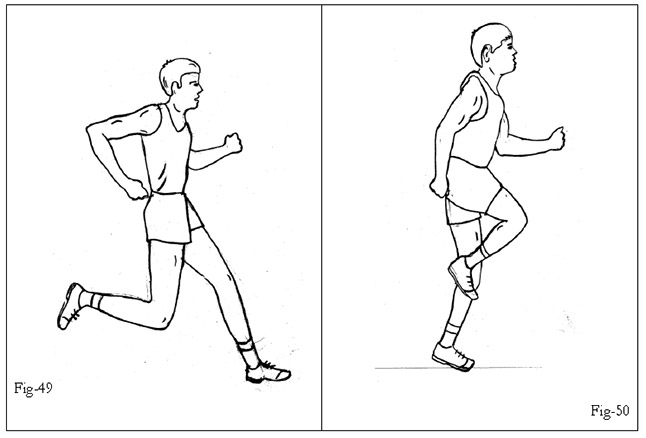
IV. HOW TO TRAIN FOR BETTER PERFORMANCE?
The following will help you to improve you long distance run performance –
(i) Slow long distance (SLD) runs – SLD runs at low intensity (60-70% of MHR) form the base of any long distance running training. Low intensity practically means such level of effort that does not make you breathless at any point of time. SLD runs increase the number of capillaries and mitochondria which contribute to faster and longer runs. (See Benefits of Endurance Running). You should run SLD once every week (not more than this). The distance of SLD should be longer than distance of your target race (e.g., 5 km, 10 km, half marathon, marathon, etc.). For example, if your target is to race 5 km, your SLD should cover more than 5 kms. Galloway’s suggestion is to run SLD of 10-12 miles if your goal is 5 km race, 16-18 miles for 10 km race, 17-19 miles for half marathon, and 28-30 miles for marathon7. I remind that while aiming for the maximum SLD, progression principle of exercise should be kept in mind. You should not increase more than 1 km distance every week.
(ii) Hill training – Hill training strengthens our legs (especially calves) and cardiovascular system by offering more resistance. The place for training can be a hill with gentle slope, or flyover or steps of stadium / stairs of a multistoried building. Hill training is hard training. It should be introduced in later part of the endurance run training only after body is sufficiently conditioned through easy SLD runs. Run up the hill at 80-90% HRR effort. Take care not to become breathless at any point of time. Relax by walking down the hill before each repetition of the hill run. The maximum duration of hill training should be 15-20 minutes. Warm up well by jogging for 10-15 minutes before doing hill training, as hill runs are very demanding. During hill runs run on your toes with slightly higher knees. Keep your body upright while running.
(iii) Interval training – Interval training consists of speed runs with rest intervals between two speed runs. It can be done on tracks in segments of 100 m / 200 m / 400 m or even more distance. Run, for
7. Running, Jeff Galloway, p.38
(iv) example, 100 mtrs, recover by jog or walk till your heart rate drops to 60% of MHR, then do the next repetition of 100 mtr, and so on. Interval training should be done at 80-90% HRR intensity and should be of 15-20 minutes duration. Jog for 10-15 minutes before starting interval training session. Interval training is very helpful in improving speed.
(v) Weight training – Weight training for endurance run focuses more on muscular endurance rather than on muscular strength. Weight training gives all the benefits of strength training (see section on Strength Training) and increases overall fitness of an endurance runner. They should train themselves by doing 2-3 sets (each set of 12-15 repetitions) of exercises (for both upper body and lower body) with less recovery time between two sets. Weight training makes their running muscles stronger and contributes to faster speed.
(vi) Walk breaks – Galloway advocates introducing frequent ‘walk breaks’ for improving performance in endurance run8. Walk break may be approximately of 1 minute duration. The idea is to take walk break whenever you feel that your running intensity is getting higher than your target rate. Take walk break before you fully exhaust yourself. You can take several walk breaks during a race. In many cases, this technique has been found to improve the performance.
V. EXERCISES TO IMPROVE ENDURANCE RUN PERFORMANCE
For overall fitness – Upper and lower body exercises mentioned in sections on strength Training and Flexibility Training.
8. Running, Jeff Galloway, p.82-85
Endurance run specific exercises –
1. Leg lift
- Sit comfortably on a high table / platform so that you feet do not touch ground (fig-51)
- Straighten and stiffen left leg and lift up, parallel to ground. Hold it for 10-15 seconds (fig-52)
- Bring the leg down to its original position(fig-51)
- Do 10 repetitions.
- Repeat the same with right leg.
- Try to keep your back straight throughout.
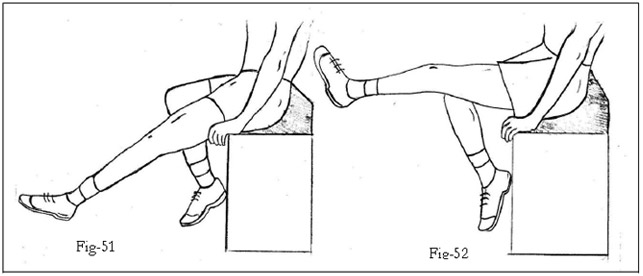
2. Ankle lift
(A)•Sit comfortably on a high table (fig-53 A)
Fix light weight to your foot.
Lift your left foot up. Hold it for 10-15 seconds (fig-53 B)
Bring it down to original position.
Do 10 repetitions.
Repeat the same with right foot.
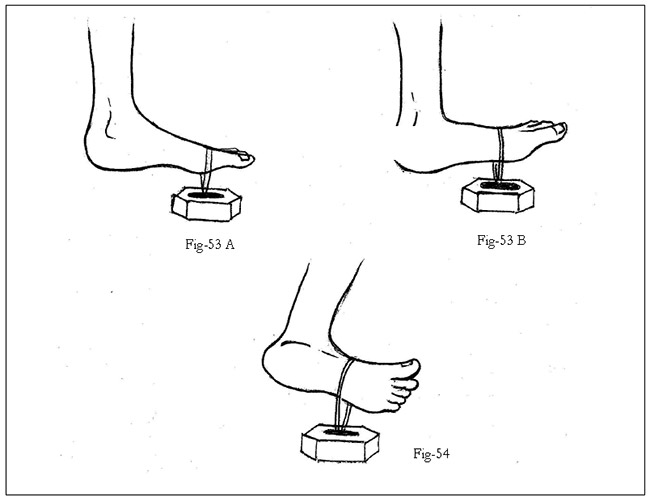
(B)• Lift your left foot inward, hold it for 10-15 seconds (fig-54)
Bring it down to original position.
Do 10 repetitions.
Repeat the same with right foot.
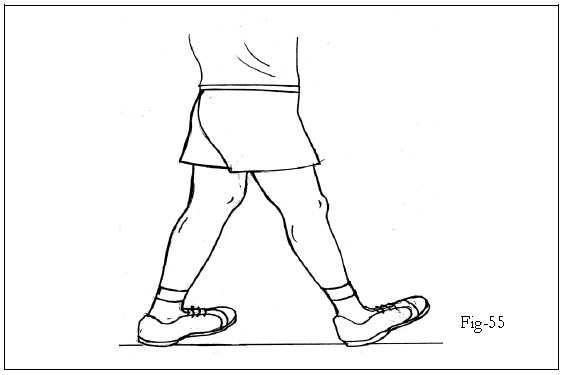
3. Handkerchief play
(A). Stand on (an imaginary) spread out handkerchief (fig-56)
With squezzing and curling action pull the handkerchief under your feet. (fig-57)
Reverse the same action to spread the handkerchief to its original position.
Do 5 repetitions.
This can also be done while sitting on a chair.

(B). Sit on a chair.
Lift your toes up. Hold it for 10 seconds. (fig-58)
Contract your toes hard. Hold it for 10 seconds. (fig-59)
Repeat the same action 10 times.
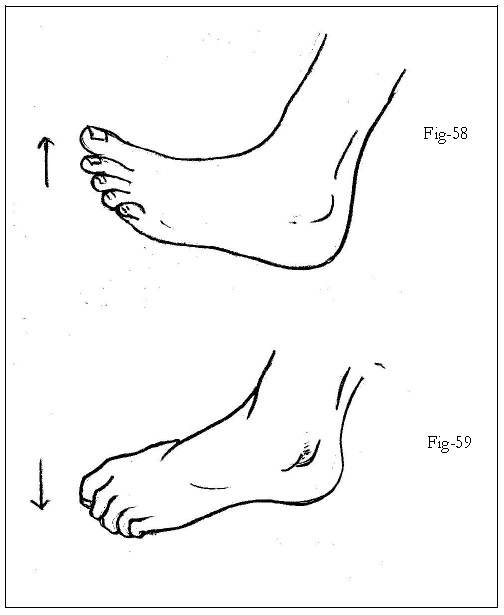
4. Phantom chair –
Sit on an imaginary chair against a wall. Head, shoulders should touch the wall, thighs parallel to the ground, feet firmly planted at 90°. (fig-60)
Sit as long as you can in this position.
Stand up and relax by taking a walk.
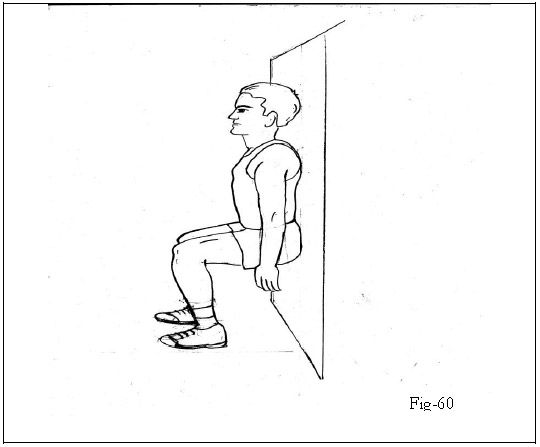
Back to top >
VI. SAFETY FACTORS –
(i) Preferably, train on soft surface (grass or dirt).
(ii) While running only on one side of the road (e.g., left side) your one foot (left foot) will always be in slightly lower position due to cambering of the road (the surface of road is higher in the middle and lower towards the sides). (fig-61). Over a period of time it may result in imbalance in your running posture and cause injury. To overcome this problem, run on the same side while on return also. This time your right foot will be in lower position (fig-62). It can be remembered this way – run 1st half of the distance on the left side of the road (left foot lower) and the other half on the right side of the road (right foot lower).
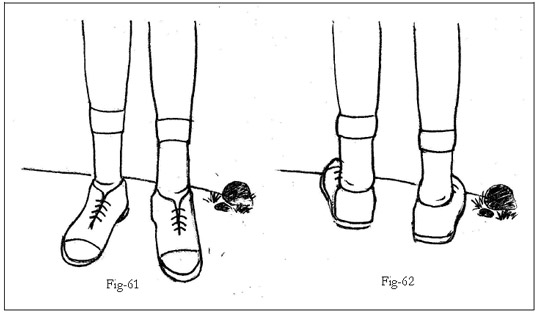 (iii) Beware of rogue drivers and dogs while running on a road.
(iii) Beware of rogue drivers and dogs while running on a road.
(iv) Hydrate yourself sufficiently, especially during long runs. Sip water in small quantity.
(v) Choose suitable shoes and socks to avoid injury.
(vi) Avoid ‘too much too soon’ approach in increasing your weekly mileage. Follow the guidelines of progression.
(vii) Don’t introduce hill training or speed training without sufficient conditioning.
(viii) Running should be an enjoyable experience. Never scare your body (and mind) by pushing yourself ‘too hard’. In endurance run improvement comes by patient, consistent efforts with sufficient recovery time allowing repairs of wear and tear.
(ix) Strength training, flexibility training must be incorporated in your training schedule for improvement in performance and injury free running.
(x) Always maintain upright posture to avoid lower back pain. Never slouch.
SPEED RUNNING
Speed is any activity continuously performed at approximately 100% effort for about 6 seconds. Generally, this is the maximum duration of time a person will be able to hold his maximum speed in a race. This is the duration in which he would ‘explode’. To be able to maintain the maximum speed beyond 6 seconds one requires a great deal of training.
I. BENEFITS
(i) Speed helps in almost all track and field sports and games. It is especially beneficial to school children to excel in school sports and games.
(ii) It helps strengthen our fast-twitch muscle fibres and thus improves speed element in endurance runs also. Speed training is an essential element in all endurance run training programmes.
II. SPEED RUNNING PROGRAMME DESIGN
A. Frequency – It depends upon your specific goal. Speed training is hard training and requires sufficient recovery time between two repetitions / sets. For a person training mainly for speed, the frequency may be 3-4 days per week; for endurance runners 1-2 days; for a normal person also 1-2 days.
B. Intensity –Speed training is done at very high intensity. Therefore, before starting next repetition or next set one should recover well by slow jog, walk and stretch to bring his heart rate to almost normal level. The number of repetitions or sets should be increased gradually every week. Be careful. ‘Too much too soon’ approach will invite injury only.
C. Time – The actual time on speed training will depend upon the number of repetitions and sets in a training session. However, since it is a hard training, total duration should not exceed 20-30 minutes. Each speed training session should start with sufficient warm-up by 10-15 minutes of jog and stretch and should be concluded with proper cool-down. Failing to warm up and cool down will make your muscles stiff and susceptible to injury.
D. Type – There is no alternative to speed running. To excel in speed run, you have to run at speed. That’s all.
III. OTHER IMPORTANT POINTS
(i) Master the correct technique and form of speed running. The technique of speed running is different from that of endurance running in the following aspects –
a) For speed, you push and land on the ball of the foot, not on the heel or flat foot as in endurance run.
b) The correct technique for a good sprint start is to start at 45 angle and then quickly move upright throughout the race (fig-63)
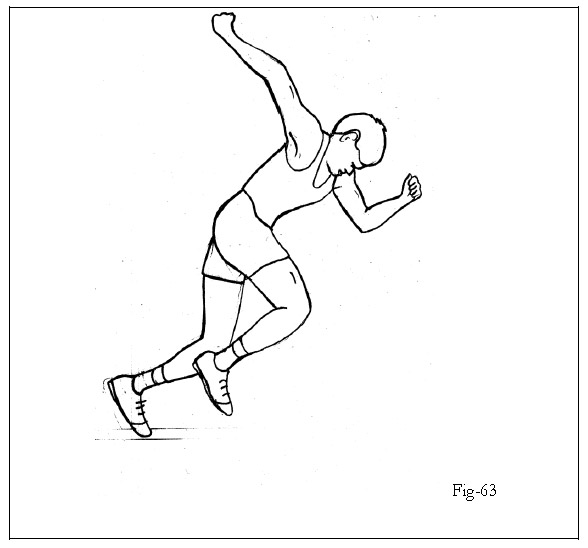
c) High knee lift (when thigh becomes parallel to the ground) combined with good stride length is correct technique of speed running. In endurance running, knees are not lifted to this degree. Here also, like endurance running technique, one should take care not to place foot far ahead of the body, but to place it directly under the hips. (fig-49 and 50).
(ii) Speed running is done not only by legs, but also by arms. The more aggressive your arms action forward and backward, the more will be your speed. Arms should be flexed to 90 and move forward and backward (maintaining the same elbow angle) almost parallel to the ground (fig-64)
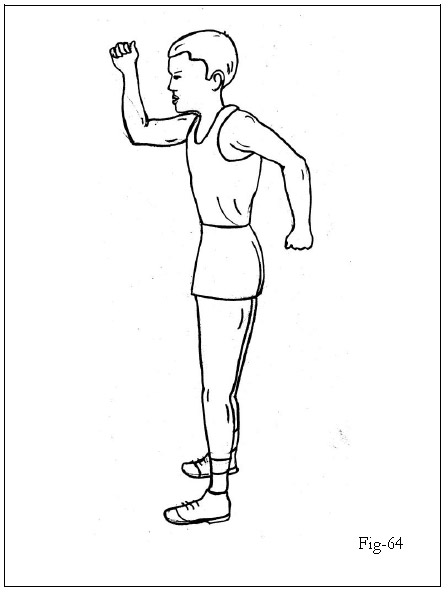
(iii) If you have to train for both speed and endurance, do it on two different days. It you have to do both on the same day, do it in two different sessions (one in the morning and the other in the afternoon). If you have to do both in the same session, complete speed training first, recover and then start endurance training.
(iv) You cannot achieve your peak training potentiality in both speed and endurance run simultaneously. Speed run is primarily dependent on fast-twitch muscle fibres and endurance run on slow-twitch muscle fibres. Therefore, you have to select your specific goal (speed running or endurance running) and train accordingly.
(v) For overall fitness, like for armed forces personnel, students or a common person, good strategy to improve both speed and endurance will be to combine the both in this manner – for two months do endurance training on 3-4 days and speed training on 2 days; next two months do endurance training on 2 days and speed training on 3-4 days, and so on. This strategy will gradually bring improvement in both while maintaining the gains in both.
IV. HOW TO TRAIN FOR BETTER PERFORMANCE?
(i) Speed running is primarily based on strength. Therefore, to improve speed overall body strength training is recommended. A look at the sprinters’ muscular body will make this point clear.
(ii) Mimic running movements while standing. For example, take small weights in hand and do arm action as you would do while running; lift knees to 90; (try to) kick your butt with your heels, etc.
(iii) Do short sprints of 10-20 mtrs with adequate recovery in between.
(iv) Wear tight shoes (in endurance training we recommended for slightly larger sized shoes) with good sole grips.
(v) Do stretching exercise religiously.
Exercises to Improve Speed Running
For overall strength and flexibility – exercises mentioned in sections on Strength Training and Flexibility.
Speed run-specific exercises –
1. Butt kicking –
Stand on your feet.
Keeping rest of the body stationary, kick your butts alternatively with both heels. (fig-65). Don’t allow your thighs to move forward or backward.
Do 30-40 repetitions with each heel.

2. Arm action –
Stand on your feet.
Hold light weight in each hand and swing your arms forward and backward simulating arm action during running. Arms should be bent at 90 at elbows throughout and upper arm will be parallel to the ground. Movement should be rhythmic.
This can be done without weights also.
3. Stride frequency drill –
Run short sprints focusing mainly on maximizing the number of strides in a given time.
You can do it in a stationary position also.
4. Stride length drill –
Run short sprints at low intensity focusing mainly on increasing the stride length.
Never overdo the stride length as it may injure you. Do some stretching exercise especially for hamstrings and calves to avoid injury.
V. SAFETY FACTORS
(i) Do proper warm-up and cool-down before and after speed training session respectively.
(ii) Keep the duration of session short.
(iii) Keep your abdominal and lower back muscles strong to avoid any undue stress on you lower back.
(iv) Speed training is mostly a safe training.



